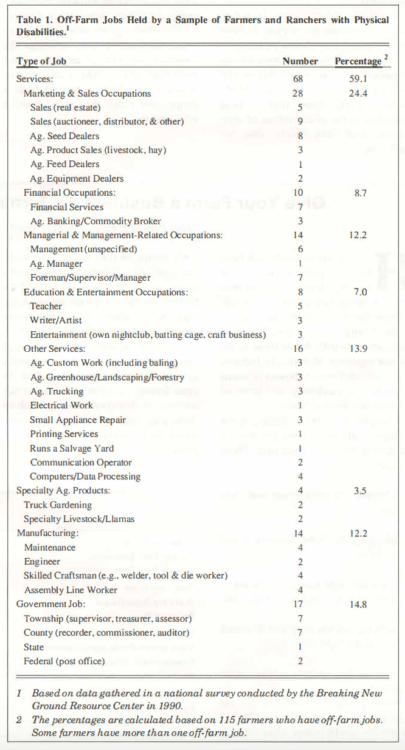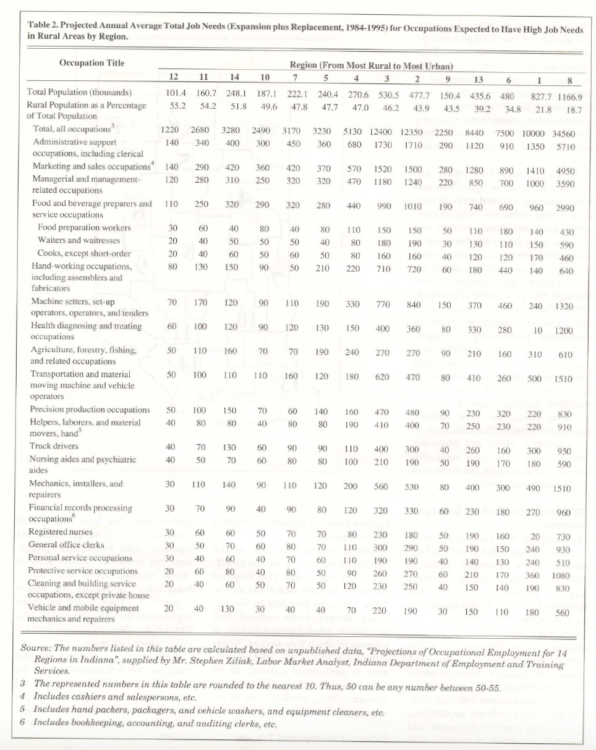Where Will Indiana Farmers with Physical Disabilities Find Jobs?
March 16, 1992
PAER-1992-03
Ziyou Yu, Graduate Research Assistant and Deborah. I. Brown, Associate Professor
The Problem
Off-farm income has become increasingly important for U.S. farmers. The 1989 regional farm survey (Lasley and Fellows, 1990) indicated that 38% of operators and 47% of spouses in the North Central region worked off-farm in 1988.
Off-farm jobs are also very important for farmers with physical disabilities. The results of a recent survey of farmers and ranchers with physical disabilities (Breaking New Ground, 1990) showed that 27 .6% of the respondents held off-farm jobs, averaging 36.4 hours per week.
Farmers with disabilities are at a disadvantage in finding such off-farm jobs, handicapped by both their physical disability and their rural locations. The Breaking New Ground (BNG) survey showed that 50% of the responding farmers believed that their disability was a major barrier to obtaining offfarm jobs, while 47% believed that a lack of local (generally rural) jobs was a major problem. Regardless of difficulties, many of these farmers did find jobs. The J 990 BNG survey indicated that of the 37% who looked for off-farm jobs, 75% found them. We will briefly describe the survey results and other information that may help Indiana farmers with disabilities find off-farm jobs.
General Trends in Rural Development
Nationally, the non-metropolitan unemployment rate has remained above the metropolitan rate throughout the 1980s (Brown, et al., 1988). Most new jobs through the year 2000 are expected to occur in service industries (U.S. Department of Commerce, 1991), and most service jobs are concentrated in large metropolitan areas (Miller and Bluestone, 1988). Total agricultural and manufacturing employment, which is a disproportionate share of rural employment, is expected to decline (Kutscher, 1988).
However, nationally there are growth areas even in agriculture and manufacturing, and rural areas do have some service industries. In agriculture, jobs as gardeners, groundskeepers, and farm managers are expected to increase. In manufacturing, jobs in meat production, in the paper industry, and in the wood industry are expected to grow through the year 2000 (Personick, 1986). The construction industries are also projected to need large numbers of employees, particularly carpenters, electricians, painters, paperhangers, and plumbers (Silvestri and Lukasiewicz, 1987). Rural counties do have concentrations of some services, including dealerships and gas stations, hardware stores, real estate services, loan and insurance offices, and agricultural services (Miller and Bluestone, 1988). Jobs in a particular occupation may decline as a whole, but increase in some geographic areas.
Off-Farm Jobs Held by Surveyed Farmers
The Breaking New Ground Resource Center was established in 1979 at Purdue University to provide technical assistance to farmers and ranchers with physical disabilities. In 1990, the Resource Center conducted a survey of employment experiences of farmers/ranchers with physical disabilities. It was distributed to 1,700 farmers nationwide. The surveyed group were farmers with serious physical disabilities who had contact with the BNG program between 1980 and 1990. The disabilities included amputations, severe visual impairments, spinal cord injuries, and multiple disabilities. This was not a random sample of farmers with disabilities, but it is the largest such list available in the country. Four hundred thirty-six farmers responded. a 25.6% return rate.
One hundred fifty-four of the responding farmers had looked for off-farm employment, and 115 of them had off-farm jobs at the time of the survey. Table 1 lists the jobs held by the surveyed farmers. Some reported their occupation; others reported the type of business in which they worked. Nearly a third (26.7%) of the off-fa1m jobs were in agricultural services, 18.3% were in manufacturing, 43.5% were in non-agricultural services, and 14.8% were in government.

Table 1. Off-Farm Jobs Held by a Sample of Farmers and Ranchers with Physical Disabilities
Indiana Employment Trends
Apart from the experience of the surveyed farmers, there are several employment projections that may be used to help find local employment opportunities. State governments regularly make employment projections for economic sectors such as “Food Manufacturing” and “Retail Food Sales.” In Indiana, the Indiana Department of Employment and Training Services (IDETS) (phone 317-232- 8550) makes these projections for each of 14 regions (see Figure 1 map).

Figure 1. Map of 14 Economic Regions in Indiana
Employment projections are also made for over 600 occupations for the same 14 regions. Real estate agents and truck drivers are examples of the types of occupations included in these projections. These can also be obtained from IDETS.
One problem in using these projections to obtain information on rural employment opportunities is that the projections are made for a region. A region usually consists of both urban and rural counties, thus job opportunities in the rural counties of each region are unclear. However, one can begin to evaluate rural employment opportunities by looking at jobs which are expected to grow well in the relatively more rural regions of a state.
The most recent IDETS projections for 1984-1995 for 14 Indiana regions were examined and the occupations which were expected to offer the most jobs in the more rural regions were identified. Table 2 shows 21 occupations that were expected to offer a large number of jobs in the more rural regions.

Table 2. Projected Annual Average Total Job Needs (Expansion plus Replacement, 1984-1995) for Occupations Expected to Have High Job Needs in Rural Areas by Region.
Occupations expected to offer greater employment opportunity in rural Indiana counties for 1984-1995 were administrative support, marketing and sales, managerial and management, food and beverage preparers, and service. Surveyed farmers’ responses cannot be categorized in exactly the same way as the occupation projections, because the surveyed farmers sometimes told who they worked for, but not what they did. Given this disparity, compare the occupation projections of Table 2 with the off-farm jobs held by the surveyed farmers shown in Table 1. Most of the surveyed farmers held off-farm jobs in sales (24.4% of the total off-farm employment), government (14.8%), and management or administration (12.2%). Disabled farmers nationally had found jobs in three of the four occupations projected to grow well through 1995 in rural Indiana.
Conclusions
Most future U.S. jobs are expected to be in non-agricultural services. Most such service jobs are located in urban areas. The surveyed farmers with disabilities who worked off-farm were mostly in service jobs (68 of 115). Their experiences, therefore, mirrored national trends. However, a large number of farmers with disabilities worked in agricultural services, a sector not projected to grow much nationally, but expected to offer a fair number of jobs in more rural Indiana regions.
It appears that projections of which sectors or occupations will have many job openings can help suggest possibilities to this group of farmers, but judging by the experiences of farmers with disabilities who have jobs in sectors which were not expected to grow between 1984 and 1990, these projections should not be taken as limits.
* We would like to thank Mr. Steve Ziliak of the Indiana Department of Employment and Training Services and Ms. Judy Erickson of the Iowa Department of Employment Services for their great help.
** Support for this work was provided by the National Institute on Disability and Rehabilitation Research, Grant Number H133A 90004-91.
Sources of Additional Information
Brown. D.L. and K.L. Devers, “Rural Change and the Rural Economic Policy Agenda for the 1980’s,” in Rural Economic Development in the 1980’s: Preparing for the Future, Washington, DC: Agriculture and Rural Economy Division, Economic Research Service, U.S. Department of Agriculture, Rural Development Research Report No. 69, pp. 1-29, 1988.
Clemons, Nanette, “Alternative Farm Enterprises for Farmers with Disabilities,” Breaking New Ground Newsletter, Vol. 9, No. I, Winter 1991.
Kutscher, R.E., “Overview and Implications of the Projections to 2000,” Monthly Labor Review. Vol. I IO. No. 9. pp. 3-9. September 1987.
Miller, J.P., H. Bluestone, “Prospects for Service Sector Employment Growth in Nonmetro America,” in Rural Economic Development in the 1980’s: Preparing for the Future, Washington. DC: U.S. Department of Agriculture, Agriculture and Rural Economy Division, Economic Research Service, Rural Development Research Report No. 69, pp. 135-158, 1988.
Lasley, Paul and Jacqueline Fellows, “Farm Family Adaptations lo Severe Economic Distress: Regional Summary, Results of the 1989 Regional Farm Survey.” North Central Regional Center for Rural Development, RRD 154, August 1990.
Personick, V.” Industry Output and Employment Through the End of the Century,” Employment Projections/or 2000, U.S. Department of Labor, Bureau of Labor Statistics, pp. 44- 61, March 1986.
Silvestri, G.T. and J.M. Lukasiewicz, “A Look at Occupational Employment Trends to the Year 2000,” Employment Projections for 2000, U.S. Department of Labor, Bureau of Labor Statistics, pp. 44-61, March 1986.
U.S. Department of Commerce/International Trade Administration, U.S. Industrial Outlook, 1991. [This gives an evaluation of the economic prospect for most U.S. economic sectors, and is published annually.]
